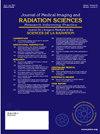Lived experiences of radiographers assigned to veterinary clinics in the Philippines: A qualitative study
IF 1.3
Q3 RADIOLOGY, NUCLEAR MEDICINE & MEDICAL IMAGING
Journal of Medical Imaging and Radiation Sciences
Pub Date : 2025-04-11
DOI:10.1016/j.jmir.2025.101901
引用次数: 0
Abstract
Background
Radiographers in the Philippines are increasingly assigned to veterinary clinics, where they perform diagnostic imaging for animals using x-ray machines. This practice is not typical, as the formal education and curriculum for radiographers mainly focus on human applications. With the growing demand for veterinary radiography, understanding the experiences and challenges faced by radiographers in this context is crucial. There is limited research on the subject, particularly in the Philippines.
Objective
This study aimed to explore the lived experiences of radiographers working in veterinary clinics in the Philippines.
Methods
A qualitative, descriptive phenomenological approach was employed to capture the experiences of 14 board-certified radiographers working in veterinary clinics in two highly urbanized cities in the Philippines. Data were collected from August to November 2024 through semi-structured, in-depth interviews conducted via Zoom. Thematic analysis was used to analyze the data, identifying key themes and categories.
Results
The study identified four main themes: (1) Technical challenges in adapting to veterinary radiography, including adjusting positioning techniques and dealing with equipment limitations; (2) Physical and emotional challenges, including physical strain from handling large animals and the emotional toll from witnessing animal suffering and managing pet owners' expectations; (3) Lack of formal training in veterinary radiography and the reliance on pre-employment training and mentorship from colleagues and veterinarians; (4) A fulfilling career in veterinary radiography, with participants reporting a strong sense of purpose in helping animals and gratification from supporting pet owners.
Conclusion
The study highlights the significant challenges faced by radiographers working in veterinary clinics, particularly in terms of technical adaptation, physical demands, and emotional strain. However, despite these challenges, radiographers found their careers to be rewarding and fulfilling. The findings suggest the need for formal training in veterinary radiography and the development of support systems to enhance the professional development and well-being of radiographers in this unique setting.
分配到菲律宾兽医诊所的放射技师的生活经验:一项定性研究
背景菲律宾越来越多的放射技师被派往兽医诊所,使用 X 光机为动物进行影像诊断。这种做法并不典型,因为放射技师的正规教育和课程主要侧重于人类应用。随着兽医放射摄影需求的不断增长,了解放射技师在这方面的经验和面临的挑战至关重要。本研究旨在探讨在菲律宾兽医诊所工作的放射技师的生活经历。研究采用定性、描述性的现象学方法,收集了在菲律宾两个高度城市化的兽医诊所工作的14名获得认证的放射技师的经历。数据收集时间为 2024 年 8 月至 11 月,通过 Zoom 进行半结构化深度访谈。采用主题分析法对数据进行分析,确定关键主题和类别。结果该研究确定了四个主题:(1)适应兽医放射摄影的技术挑战,包括调整定位技术和应对设备限制;(2)身体和情感挑战,包括处理大型动物带来的身体压力、目睹动物痛苦带来的情感伤害以及管理宠物主人的期望;(3)缺乏正规的兽医放射摄影培训,依赖岗前培训以及同事和兽医的指导;(4)兽医放射摄影是一个充实的职业,参与者表示在帮助动物时有强烈的使命感,并从支持宠物主人中获得满足感。结论这项研究强调了在兽医诊所工作的放射技师所面临的重大挑战,尤其是在技术适应、体力要求和情绪压力方面。然而,尽管面临这些挑战,放射技师们仍然认为他们的职业是有意义和有成就感的。研究结果表明,有必要对兽医放射技师进行正规培训,并建立支持系统,以促进放射技师在这一独特环境中的职业发展和福祉。
本文章由计算机程序翻译,如有差异,请以英文原文为准。
求助全文
约1分钟内获得全文
求助全文
来源期刊

Journal of Medical Imaging and Radiation Sciences
RADIOLOGY, NUCLEAR MEDICINE & MEDICAL IMAGING-
CiteScore
2.30
自引率
11.10%
发文量
231
审稿时长
53 days
期刊介绍:
Journal of Medical Imaging and Radiation Sciences is the official peer-reviewed journal of the Canadian Association of Medical Radiation Technologists. This journal is published four times a year and is circulated to approximately 11,000 medical radiation technologists, libraries and radiology departments throughout Canada, the United States and overseas. The Journal publishes articles on recent research, new technology and techniques, professional practices, technologists viewpoints as well as relevant book reviews.
 求助内容:
求助内容: 应助结果提醒方式:
应助结果提醒方式:


